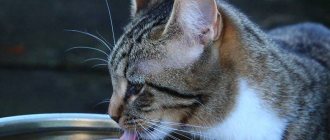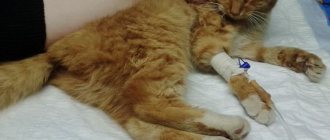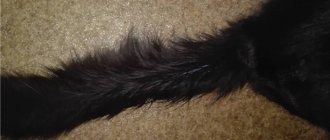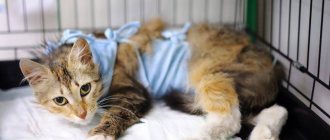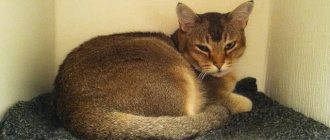February 8, 2018
Crying while watching a melodrama is quite normal for a person. But if a cat starts crying, then you need to start sounding the alarm and take a close look at his well-being! If your cat's eyes are watery, you should pay attention to the state of its health.
Of course, veterinarians note the fact that by nature, cats' eyes can water from time to time. For example, in kittens under the age of one year, this occurs in 70% of cases. However, any responsible owner of even an adult cat should periodically carefully examine the eyes of their pet.
Why do cats have watery eyes: causes and symptoms
What kind of discharge from a cat's eyes can be considered normal? Veterinarians are unanimous on this issue: minor discharge that accumulates in the corners of the eyes is absolutely normal. They represent a physiological norm. It is enough to remove them regularly. To do this, you can use cotton swabs, after moistening them with water, or cotton pads. You can purchase specialized eye drops.
There’s no need to guess about the reason why a cat’s eyes are watery either. In the case when the baby was torn away from his mother at a very early age, the baby’s eyes may turn sour due to a banal inability to take care of himself. He just didn't have time to learn it. As the pet grows, it will gradually acquire this skill and begin to independently care for its face, wash it like an adult cat and carry out other hygiene procedures.
However, if the owner notices that the cat periodically rubs its eyes with its paws, he should be wary. This is a direct signal that something is wrong. The main task for the owner is now to take his pet to the veterinarian as soon as possible.
A prerequisite is to visit a cat doctor with your pet, since in this matter an examination of the animal is simply necessary. There are many reasons for excessive lacrimation, which means that no conscientious veterinarian would take on the responsibility of prescribing treatment in absentia.
The main diagnosis, which is most often made by a doctor, for such symptoms is inflammation of the conjunctiva and, in other words, conjunctivitis. However, you should not relax from some familiarity of the diagnosis. This disease looks harmless only at first glance. As a rule, its causes often include a list of viral, bacterial, invasive and other diseases.
What are the main causes of watery eyes in cats?
There are many reasons why a cat's eyes become watery. Among them there are both quite harmless and dangerous eye diseases.
1. Missed vaccination.
If the baby's eyes begin to water often and a lot, the owner needs to think about whether he missed the time for vaccination? The fact is that kittens have not yet fully developed immunity and infections or viruses that enter their body can manifest themselves in a similar way, in the form of teary eyes.
2. Features of the breed.
Some cat breeds have slightly rolled-up eyelids as a characteristic feature, which can cause small cracks in the skin. The dirt that gets into them can cause the development of conjunctivitis.
There is an opinion that entropion (the phenomenon of a rolled eyelid) can occur in absolutely any cat. However, in practice, in outbred cats, this occurs in isolated cases. But in British cats, Maine Coons, Sphynxes, Persian cats, Scottish fold kittens, a rolled eyelid is quite common. Unfortunately, in such a case, only surgical intervention will help overcome the phenomenon of tearing of the eyes.
3.Allergy.
Watery eyes may be a symptom of an allergy. Its main causes and irritants can be: the pungent smell of chemicals, aerosol, deodorant, which the owner is used to using daily while at home. They can become a direct cause of the appearance of such eye pathology. An allergic reaction can also develop from a pet’s consumption of certain foods. Allergies can also be caused by poplar blossoms, namely its fluff, plant pollen, and cosmetics. In the case of food allergies, this problem is solved by simply eliminating the allergen from the animal’s diet. In other cases, only hormonal medications carefully selected by a veterinarian will help get rid of it.
Virus.
Viral, bacterial or fungal disease, namely the manifestation of mycoplasmosis, calcivirosis, herpesvirosis, toxoplasmosis, chlamydia, etc. Tearfulness of the eyes is a direct symptom of the listed (and not only) diseases, and therefore only a good veterinarian.
Inflamed cornea of the eyes.
In the case when the eyes are watery and at the same time covered with a film, then such a symptom may well be a symptom of an inflamed cornea, in other words, keratitis.
Cataract.
If the lens is smoky or white, then this is direct evidence of cataracts.
Increased main pressure.
Tearfulness can cause increased eye pressure in a cat. In addition to the appearance of discharge from the eyes, the appearance of increased eye pressure can lead to blindness of the pet.
Blockage of tear ducts.
Clogged tear ducts from birth or acquired during the animal's life are another reason why a cat's eyes may become watery.
Parasites.
If the owner notices that one of the cat’s eyes is watering, this may give him a signal that he needs to remember the last time he dewormed his pet. Timely extermination of parasites in the animal’s body can stop the disease in time and prevent it from developing into a more severe form.
Cold.
If the cat began to rub his watery eyes and sneeze, then he could simply have a cold, like a person.
Eye injury.
Of course, we cannot discount the possibility of simple eye injuries. However, there is one caveat here. In such cases, as a rule, the eye that was injured more is more watery.
Based on all of the above, it is necessary to recall once again that the true cause can only be determined by a veterinarian after examining the animal.
Possible reasons
Souring eyes can be treated at home if the problem is caused by foreign objects or ordinary irritation of the mucous membrane. In all other cases, it is recommended to visit a veterinarian.
Possible causes of thick discharge from the eyes in cats:
- allergic reaction;
- eye injuries;
- fungal, viral and bacterial diseases;
- eye diseases;
- parasites in the body.
Parasitic eye lesions are quite common in small kittens. The problem is caused by a large number of worms and the general weakness of the baby’s body. Typically, extensive worm infestation is accompanied by lethargy, lack of appetite, nausea and vomiting. The eyes sour with a thick, light-colored mass; there is no specific odor.
In case of an allergic reaction, crusts may form on the cat's face. The eyes look inflamed and there is profuse lacrimation. Your pet may sneeze, shake its head, and try to rub its eyes with its paw.
With systemic fungal infections, thick discharge may appear in the corners of the eyes. Typically, the exudate is light in color and can irritate the mucous membranes of the eyes and cause swelling. At this time, the animal feels itchy and behaves restlessly.
With viral and bacterial diseases, specific symptoms are always present, such as fever, diarrhea, general weakness and loss of strength. One of the characteristic manifestations of systemic lesions of the body are pain in the eyes and conjunctivitis, in which the cat’s eyes turn brown.
Why do my cat's eyes turn sour?
If in the case of a kitten’s slightly tearful eyes, the problem can resolve itself, then souring of the eyes is a very bad symptom, which indicates that the disease that caused it is beginning to develop into a more severe form.
A cat’s eyes fester both for a number of reasons that were mentioned earlier, and for such serious diseases as, for example, feline distemper. The appearance of purulent discharge, in itself, is a direct clue as to which direction to look for the problem.
If they are transparent and watery, the cause may be an allergic animal.
If the discharge is brown, yellow or green, and at the same time has a thick consistency, the animal’s eyelids stick together, then this is a direct sign of the presence of an infectious disease.
When visiting a veterinary clinic, a cat whose eyes are sour will be washed from the conjunctiva and a series of clinical tests will be carried out to determine the causative agent. Upon completion of these studies, a diagnosis will be made and recommendations for further treatment of the pet will be given.
You should visit a veterinarian if you have the following symptoms:
- red eyes on a cat;
- swollen eyelids;
- changed color of the fur around the eyes;
- photophobia;
- lack of appetite;
- cat lethargy;
- whitened lens of the eye;
- film on the eyeballs.
How to wash the eyes of a kitten or cat as a preventive measure
It is recommended to monitor the condition of your cat's eyes from an early age. In newborn kittens, the eyes open in one to two weeks. If by the end of the third week the eyes have not opened, you need to wash them very carefully.
Adult cats take care of their own hygiene. The daily cat ritual includes washing the face and eyes. But it happens that the cat gets hurt or catches a disease - to prevent complications, periodically examine your pet. If you notice clouding or change in color of the iris, purulent discharge, or fur on the face with traces of tears, then immediately contact your veterinarian. If an injury is detected, do not let the animal rub its eye, as this irritates the mucous membrane. Do not open your pet's eyes by force. Do not use medications containing prednisolone or dexamethasone yourself - you may worsen the situation.
The treating veterinarian will advise what to wash your cat's eyes with as a preventive measure. You can soak a cotton pad with strong tea or saline solution, and then clean the eye with smooth movements. All this is necessary if the cat periodically develops brown crusts - the consequences of poor hygiene and dust getting on the cornea. This is not dangerous if the accumulations are removed from the tear corners in time.
Do not forget to vaccinate your animal once a year, without losing track of the schedule. If you have an elderly or frail pet, take it to the veterinarian regularly.
In the case when simple medications do not help and your pet’s eyes continue to fester, become swollen and stick together, it is necessary to take the animal to the veterinarian. The doctor will make an accurate diagnosis and prescribe age- and breed-appropriate treatment.
The article is of a recommendatory nature. Consult your veterinarian!
How to wipe a kitten's eyes?
It would be most optimal to choose calendula, St. John's wort, chamomile and sage for such a procedure. They will help you easily remove accumulations of minor discharge from your kitten’s eyes.
If necessary, you can wash your cat's eyes by:
- homemade herbal tincture (chamomile);
- furatsilin solution (1:5000);
- boric acid solution (2%).
Eye drops for daily care
- Leopard;
- Diamond eyes.
In cases where the manifestation of tearing has become pathological, veterinarians often prescribe eye drops for bacterial conjunctivitis:
- chloramphenicol;
- kanamycin;
- sodium sulfate;
- Sofradox.
In a number of individual cases, ointment containing antibiotics and eye films help quite well.
Manifestations of allergic tearing should disappear upon completion of the hormonal course of treatment.
If the infection is caused by a virus, then only a veterinarian can advise its treatment.
Treatment and prevention
Treatment should be prescribed by a veterinarian after an accurate diagnosis has been made. A trip to the veterinarian or calling a specialist to your home is the first thing the owner should do. The veterinarian will want to know when deworming was carried out, vaccinations, the cat’s diet, how and when lacrimation appeared, what preceded it - be prepared to answer these questions.
Treatment
For treatment, drops from veterinary and regular pharmacies, antibiotic ointments and eye films are most often used.
If lacrimation has become a pathology, then veterinarians most often prescribe instillations for bacterial conjunctivitis:
- Levomycetin - antimicrobial drops with rapid local action. The antibiotic is sold in a regular pharmacy. It is inexpensive: a bottle of 5 ml. 6 rubles (9 UAH);
- Kanamycin is a medicine for bacterial diseases. The antibiotic can be purchased in pharmacies for 12 rubles. (13 UAH);
- Sulfacyl sodium – transparent eye drops for the treatment of people. Approved for use in cats for eye diseases. The antimicrobial drug is sold in regular pharmacies - a bottle costs 27 rubles. (16 UAH);
- Sofradex is an antibiotic with anti-inflammatory and antiallergic effects. Prescribed for superficial eye infections, allergic conjunctivitis. In Russia the bottle is 5 ml. Costs 326 rubles, in Ukraine – 64 UAH.
Allergic tearing, as we have already written, goes away after the end of the hormonal course of treatment.
But only a specialist will tell you what to do in case of a viral infection and how to treat it!
How to properly instill eye drops
All therapeutic procedures should be carried out in a calm, natural environment. Stroke, caress the cat, talk to it in a gentle and calm voice.
If you are not sure that you can handle the animal on your own, call someone for help - let the assistant hold the cat in his arms during the procedure. Overly aggressive animals can be pre-wrapped in a terry towel.
Your next steps:
- Soak a cotton pad in warm water and wash your cat's eyes. Rinsing is a mandatory step before each instillation.
- Take the bottle of medicine in your right hand, and with your left hand pull the eyelid down.
- Place the required number of drops into the resulting gap.
- Make sure that the medicine gets into the eye and not onto the animal's fur.
- After instillation, hold your pet tightly; at this time, he feels itching and burning. It is necessary to hold it so that the cat does not scratch the itchy eye with its paw.
- Be sure to praise and pet the cat after all manipulations. Give your pet his favorite treat.
Important!
For local therapy, in addition to drops, eye ointments with an antibacterial effect can be prescribed: “Levomycetin”, “Tetracycline”. They need to be placed behind the third eyelid.
Prevention
To prevent your kitten's eyes from watering, follow these rules:
- No drafts.
- Do not let your cat become hypothermic.
- Follow the vaccination schedule and strengthen the animal's immunity.
- Don't ignore preventive visits to the veterinarian.
- Carry out anti-parasitic measures regularly.
- Monitor the condition of your pet's eyes.
- Choose your diet wisely.
- Do not allow your pet to come into contact with poisonous or toxic substances. Keep household chemicals out of reach.
- Brush your cat carefully to keep hair out of your eyes.
- Avoid touching your cat's eyes with dirty hands.
- Do not allow the mustache to come into contact with homeless and sick relatives.
- Keep your home clean.
Eye washes and drops can be used for prevention in kittens and adult animals.
How to wipe and rinse a cat's eyes
When the doctor has already prescribed treatment for the cat’s eyes and the procedures are carried out at home, it will not be a bad idea to read the short instructions.
You need to prepare:
- several gauze napkins/cotton pads;
- pipette/disposable syringe;
- towel;
- delicacy!
Action 1.
It is necessary to catch and secure the pet, wrap it in a towel. If the procedure is being carried out for the first time, then it would be quite appropriate to invite other family members to provide assistance, since the animal in panic may begin to break out with a force that the owner had no idea about before. The presence of a towel is necessary so that a desperately resisting cat does not injure its owner. As a rule, pets do not really like various kinds of manipulations.
Action 2.
A number of necessary manipulations should begin. A napkin or cotton pad should be soaked in the medicinal solution, soak the crusts and remove them.
Action 3.
You need to take a new cotton pad or napkin and soak it in the medicinal solution. Using your thumb and index finger, separate your eyelids and rinse them, moving from the outer corner of the eye to the inner. You need to try to wet the conjunctiva generously with the solution. If you have sufficient experience, the rinsing procedure can be carried out using a disposable syringe (without a needle), injecting the solution directly under the eyelids.
Action 4.
You need to blot your pet's eyes with a dry and clean napkin or cotton pad.
Action 5.
Next, you should appease your pet with his favorite treat. Surely, performing these procedures became stressful for him. If the animal is very offended, you can add a double portion of treats.
In conclusion, it must be said that regular eye hygiene, fur care, teeth cleaning, manicure/pedicure should become a number of familiar procedures for your pet fluffy.
Tags: Health, Treatment, Veterinarians' opinion, Disease prevention
How to apply medicinal ointment correctly
Tetracycline ointment is preheated in your hands so as not to frighten the kitten with a cold touch. It is best to turn the animal on its side, fixing it in this state. It is difficult to cope with eye treatment in kittens alone, since one person must hold the cat, and the other must perform the necessary manipulations.
We invite you to familiarize yourself with “Pronature” - a holistic-class product! What's behind the big name?
The ointment is placed directly under the lower eyelid, so it must be pulled off very carefully and at the same time with your fingers (your hands should also be warm), and the tetracycline ointment should be placed inside the eyelid with the finger of the other hand. Cover the eyeball with the ointment and lightly massage it for a minute, trying not to cause pain to the kitten.
Treatment of conjunctivitis - what to use at home?
Unlike diseases that are dangerous to a cat’s health, it is quite possible to cope with conjunctivitis on your own, making sure that there are no additional signs of serious illness. A mandatory rule for home treatment is to closely monitor the animal’s condition; if no results are observed, it is better to go to the veterinarian. Usually, drops are used for treatment, which destroy the infection that caused souring. Most often it is recommended to use Levomycetin, which copes with most types of bacteria. The peculiarity of the drug is that it does not penetrate the tissues of the eyeball or skin, acting only on the surface of the mucous membranes. Thanks to this, negative reactions or side effects are quite rare.
In addition to the use of medications, it is recommended to use home remedies that are no less effective in treating the disease. The only rule is to use home recipes only for allergic or inflammatory types of conjunctivitis. Rosehip decoction is one of the most effective remedies against sour eyes in animals. It's easy to prepare:
- Pour boiling water (200 ml) over rose hips (30 g).
- Send the container to low heat.
- Simmer covered for a quarter of an hour.
- Leave for an hour, wrapping the container in a towel.
Rinse the animal's eyes every 3-5 hours. It is convenient to do this with cotton wool discs, but remember to use a clean sponge every time. The duration of treatment is a week, usually this time is enough to cope with the disease. Sour eyes do not always indicate a serious illness, but it is better not to refuse the help of a veterinarian. Only after a specialist determines that there is no danger to the cat can you resort to home treatment and use simple remedies.
